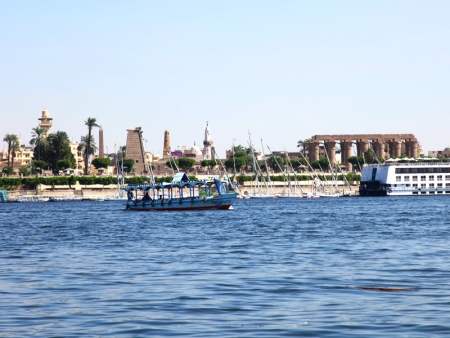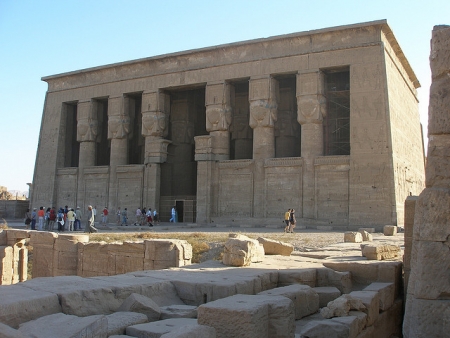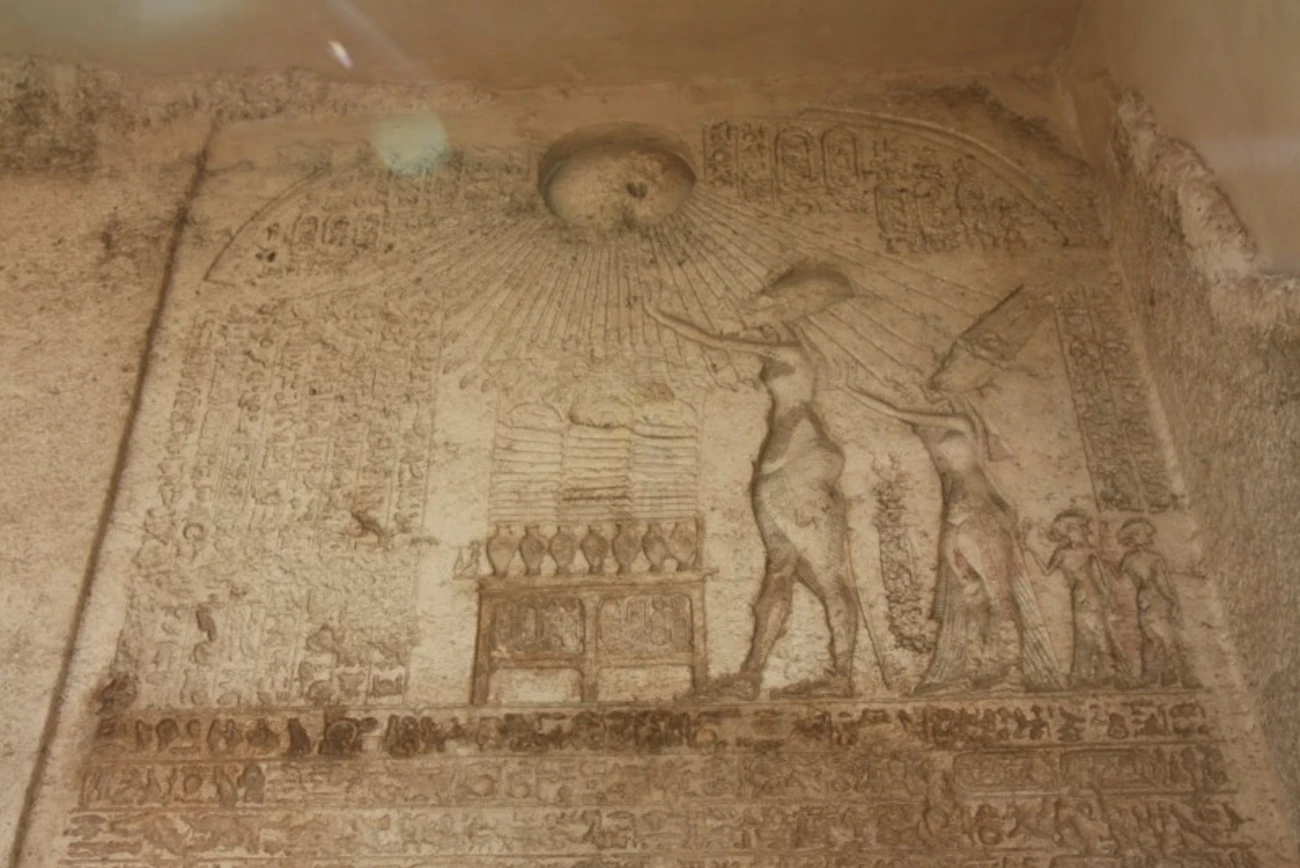The site lies on the Eastern Bank of the Nile, 20 km south of the city of Al-Minya. It houses 39 rock-cut tomb decorated with scenes depicting local and regional life during the Middle Kingdom. Many of these have scenes of violent warfare and military training.
They include:
Tomb of Amenemhet (tomb 2): Amenemhet is described as the 'prince of the Oryx Nome' and was a governor of the Oryx nome. Here one finds one of two inscriptions within the necropolis that help define Egyptian life in this period. It consists of thirty-two lines on the door. There are also unusual scenes depicting hunting in the desert on the north wall. His tomb is unusual for having a false door on the west, where the dead are suppose to enter.
Tomb of Khnumhotep (tomb 3): A governor under Amenemhet III (about 1820 BC), Khnumhotep's is described as 'the hereditary lord' and his tomb is beautifully done with scenes of daily life. His biographical inscription within the tomb is 222 columns of text and help define Egyptian life during this period. There are also acrobats over the door.
Tomb of Khnumhotep I (tomb 14)
Tomb of Baqet III (tomb 15): If ever there was an imaginative person, the father of Kheti (see below) was one. A strange tomb with scenes depicting a hunt for unicorns, a serpent-headed quadruped, a 'Sethian' animal and a griffin. Apparently, the Egyptians felt that their were evil forces in the desert, and hunting their helped to preserve order. Others show wrestlers and gazelles involved in strange behavior.
Tomb of Kheti (tomb 17): During the 11th Dynasty, Kheti was a governor of the Oryx nome. The tomb has depictions of daily life during the period.
About two miles south is the Temple of Hatshepsut in an area popularly called Istabl Antar (Stables of Antar).
Egypt Travel Guide
Egypt Oases
- Gara Cave
- Al-Deer
- Badr's Museum
- Bagawat
- Black desert
- Cleopatra bath
- Great Sand Sea
- Mizawaka
- Monastery of Anba Bishoy
- Mountain of the Dead in Siwa | Gebel al-Mawta
- Qarun Lake
- Roman Temple in Deir El-hagar
- Temple of Alexander the Great
- Temple of Amon
- Temple of Dush
- Temple of Hibis
- Temple of Nadura
- The Crystal Mountain | Bahariya Crystal Mountain
- The Monastery of Abu Makar (Makarios) | Egypt
- The Monastery of Baramus | Egypt
- The Monastery of El Suryan | Cairo Attractions
- Therapy in Siwa Oasis
- Valley of Al-Haiz
- Valley of the Golden Mummies
- Wadi Al- Rayan, Protected Area | Fayoum, Egypt
- Wadi El-Natroun | The Monasteries of Wadi El Natrun
- The White Desert in Egypt
- Fayoum Bird-watching Guide
Ports of Call
Red Sea and Sinai
Famous Mosques in Egypt
Transportation guide in Egypt
Egypt Tourist Attractions
Egypt Pyramids
- Djedefre Pyramid | Abu Rawash
- Abu Sir | Egyptian Necropolis & Pyramids
- King Snefru's Pyramid | Egypt
- Old Kingdom Pyramids | Ancient Egypt
- Pyramid Complex of Pepi I
- Pyramid of Amenemhat III
- Pyramid of lahun | Egypt Pyramids
- Pyramid of Meidum
- Pyramid of Neferhetepes | Egypt Pyramids
- Pyramid of Netjerkhet | Egypt Pyramids
- Pyramid of Neferefre
- Pyramid of Sahure | Egypt Pyramids
- Pyramid of Sekhemkhet
- Pyramid of Sesostris III
- Pyramid of Teti | Egypt Pyramids
- Pyramid of Userkaf | Egypt Pyramids
History of Egypt
- The False Doors | Ancient Egypt Secrets
- Egyptian Canopic Jars: What are Canopic Jars?
- Holy Family in Egypt
- king khufu (Cheops) | Kings of Ancient Egypt
- Khafre Statue | King Khafre Pyramid
- Who built the first pyramid in Egypt
- Menkaure (Mykerinos) Pyramid | King Menkaure
- Ramesses IV | Ramses iv Tomb
- Ramses IX Tomb
- The Divine Triad of Dendera
Aswan Attractions
Luxor Attractions
Alexandria Attractions
Cairo Attractions
- Famous Bab al Futuh
- Al-Tannoura Egyptian Heritage Dance Troupe
- Saints Sergius and Bacchus Church
- Abusir Pyramids & The City of The Dead Egypt
- Agricultural Museum Egypt, Cairo
- AL Fustat Historical City
- Bab El Nasr Cairo City Gate
- Beit Al Sennari or Al Sennari House in Cairo
- The Cairo Tower
- Birqash Camel Market in Cairo
- Coptic Cathedral in Abbasiya
- Egyptian Museum Guide
- El Mosky Cairo | Bazaars & Souks
- King Tutankhamun Treasures: Inside the World of Egypt’s Most Famous Pharaoh
- The Mosque of Muhammad Ali Pasha in Cairo
- Royal Mummy Room in The Egyptian Museum
- The Pharaonic Village
- The Great Sphinx of Giza
- Babylon Fortress Facts
- Solar Boat Museum
- Valley Temple of Khafre
- St Mary Egypt Orthodox Church
- Verdi Aida Opera Show in Giza Pyramids Egypt
Enjoy your cruise down the Nile with the Movenpick Royal Lily Nile River cruise. This Nile cruise offers stylish and comfortable suites, an elegant dinning room,a spacious sundeck, swimming pool and other amenities.
Plan Your Trip!
You Might Also Like

Stretch on the Nile, the world's most intensive concentration of ancient monuments, temples, tombs and places lies, constructed from the onset of the Middle Kingdom (c.2050 BC) up until Ancient Roman and Byzantine times.

Beni Hassan lies on the Eastern Bank of the Nile, 20 km south of the city of Al-Minya. It houses 39 rock-cut tomb decorated with scenes depicting local and regional life during the Middle Kingdom.

This temple is situated in Dendara city, north of Luxor about 28 miles from Luxor. It takes about 00:45 minutes.


